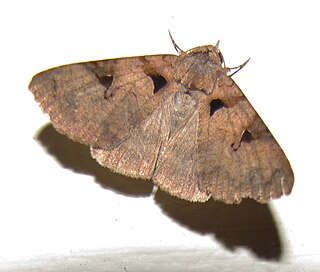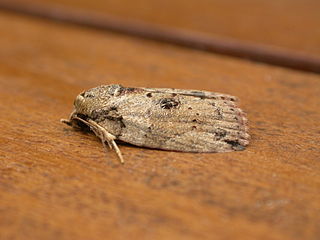
Zizula hylax, 'the Tiny grass blue' is a species of blue butterfly.

Catopsilia pyranthe, the mottled emigrant, is a medium-sized butterfly of the family Pieridae found in south Asia, southeast Asia, and parts of Australia.

Euchrysops cnejus, the gram blue, is a small butterfly that belongs to the lycaenids or blues family. It is found from India to Australia. The species was first described by Johan Christian Fabricius in 1798.

Lampides boeticus, the pea blue, or long-tailed blue, is a small butterfly that belongs to the lycaenids or gossamer-winged family.

Hypolimnas misippus, the Danaid eggfly, mimic, or diadem, is a widespread species of nymphalid butterfly. It is well known for polymorphism and mimicry. Males are blackish with distinctive white spots that are fringed in blue. Females are in multiple forms that include male-like forms while others closely resemble the toxic butterflies Danaus chrysippus and Danaus plexippus.

The dryandra moth is a species of moth that is considered to be the sole member of the family Carthaeidae. Its closest relatives are the Saturniidae and it bears a resemblance to many species of that family, bearing prominent eyespots on all wings. The common name is derived from the Dryandra shrubs of the genus Banksia, on which the larva of this species feed, and is hence restricted to the south-west of Western Australia where these shrubs grow. Other Grevillea shrubs may also be used as host plants.

The Indian fritillary is a species of butterfly of the nymphalid or brush-footed family. It is usually found from south and southeast Asia to Australia.

Hippotion celerio, the vine hawk-moth or silver-striped hawk-moth, is a moth of the family Sphingidae. It was described by Carl Linnaeus in his 1758 10th edition of Systema Naturae.

Eublemma anachoresis, the banner, is a moth of the family Erebidae. The species was first described by Hans Daniel Johan Wallengren in 1863. It is found in the Indomalayan realm, Australia and the southern part of Africa. Records include Fiji, Hong Kong, India, Sri Lanka, Japan, the Society Islands, Eswatini, Taiwan, Thailand and northern New South Wales and Queensland in Australia.

Avatha discolor is a species of moth of the family Erebidae. It is found from the Indo-Australian and Pacific tropics to as far east as Henderson Island.

Nanaguna breviuscula, the pigeonpea pod borer, is a moth species of the family Nolidae. It is found from Sri Lanka and India east to Samoa. In Australia it is found in the Kimberleys in Western Australia, the northern part of the Northern Territory and from the Torres Strait Islands and Queensland to Sydney in New South Wales.

Gesonia obeditalis is a species of moth of the family Noctuidae first described by Francis Walker in 1859. It is found from eastern Africa, the Seychelles, the Maldives and the Oriental tropics of India, Sri Lanka east to the Philippines, the Sula Islands and Australia. The adult moth has brown wings with a scalloped dark brown band near the margin. The hindwings are similar in pattern to the forewings but are a paler shade of brown.
Archernis argocephala is a moth in the family Crambidae. It was described by Oswald Bertram Lower in 1903. It is found in Australia, where it has been recorded Queensland.

Metasia familiaris is a moth in the family Crambidae. It was described by Edward Meyrick in 1884. It is found in Australia, where it has been recorded from New South Wales and Tasmania.
Metasia polytima is a moth in the family Crambidae. It was described by Turner in 1908. It is found in Australia, where it has been recorded from Queensland.
Myriostephes leucostictalis is a moth in the family Crambidae. It was described by George Hampson in 1899. It is found in Australia, where it has been recorded from Queensland.
Nacoleia alincia is a moth in the family Crambidae. It was described by Turner in 1908. It is found in Australia, where it has been recorded from Queensland.
Stemorrhages marthesiusalis is a moth in the family Crambidae. It was described by Francis Walker in 1859. It is found in India, Sri Lanka and Australia, where it has been recorded from Queensland.
Syllepte phaeopleura is a moth in the family Crambidae. It is found in Australia, where it has been recorded from Queensland.
Syllepte phricosticha is a moth in the family Crambidae. It was described by Turner in 1908. It is found in Australia, where it has been recorded from Queensland.












